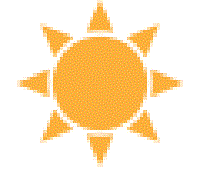THE long summer days are perfect for outdoor adventures; however, with the sun can come intense heat, which can turn your day of fun into a potentially dangerous experience. Learn how to have a good time and stay healthy and safe while adventuring in hot weather.
Plan ahead
Schedule activities in the coolest part of the day and avoid being outside during the hottest part of the day. The hours between noon to 3 p.m. are usually the hottest. On scorching days, it might just be best to avoid this time altogether by getting an early start and ending your hike by early afternoon or heading out sometime after 3 p.m. (maybe try hiking or paddling in the dark for a new and different experience!). If avoiding the hottest hours isn’t feasible, plan your trip so you can take frequent breaks in a cool or shady area or plan your activity to be near the ocean, a lake or river.
Try this tip: Dip your hat or a bandana into a lake or river, as this will help cool you down as the water evaporates.
Stay hydrated and cool
Drink plenty of cool fluids is critical, even if you don’t feel thirsty (and that means drinking water before, during and after your outdoor activity). It’s best to avoid caffeine (and alcohol) because it can cause dehydration, which stops your body from controlling its temperature properly
Try this tip: Freeze a bottle of water that can thaw into the perfect ice-cold beverage
Wear light layers
Dress for the heat and your activity level. Choose light colours (white, tan or khaki) that reflect the sun’s rays rather than absorb them (as is the case for dark colours). Make sure you pick loose clothing that breathes well, which will help your body regulate its temperature. Synthetics are good choices. Cotton can work well, too, when it’s hot and dry, but bring a change of clothing if you stay out until after the temperatures dip.
Try this tip: While it may seem counter-intuitive, covering up using a lightweight long-sleeve shirt or neck gaiter can provide effective protection from damaging UV rays.
Protect your skin and eyes
Make sure you wear a hat and apply sunscreen with SPF 30 or higher before going outside. It’s particularly important if you’re recreating on reflective snow or sand — or at elevations above 1,500 meters where the sun’s rays are more intense. Sunglasses are a must for protecting your eyes.
Try this tip: If you get burned while out on the trail, apply a cold, wet cloth to burned area to relieve pain and minimize swelling; take an anti-inflammatory painkiller; cover the sunburned areas and reduce sun exposure for the remainder of the trip, and drink more fluids.
Don’t forget about pets — and horses
Pets can get dehydrated quickly, so give them plenty of fresh, clean water when it’s hot or humid outdoors. Make sure your pets have a shady place to get out of the sun, be careful not to over-exercise them, and keep them indoors when it’s extremely hot.
Know the symptoms of overheating in pets, which include excessive panting or difficulty breathing, increased heart and respiratory rate, drooling, mild weakness, stupor or even collapse.
Try this tip: Dogs can only pant and sweat through their pads to cool off. Make sure you give your canine buddy frequent drinks of water and breaks in the shade.
For horses, equestrian trail riders need to know that their horse gets hotter much faster than humans and is more susceptible to the adverse effects of heat stress. While horses have sweat glands all over their bodies and use sweating as their primary means to cool down, sweat can’t evaporate very quickly during humid weather, potentially leading to heat stress or heat stroke in horses. Read more here about hot weather hazards and safety tips for horses.
Know what heat exhaustion feels like
Heat-related emergencies occur when the body becomes dehydrated, resulting in increased body temperature. Heat cramps, heat exhaustion, or heat stroke can happen to anyone who stays in the summer heat and sun for too long. Children, the elderly, those with chronic illnesses such as heart disease, and those taking certain medications can become ill in hot, humid weather faster than healthy adults.
Make sure you know the signs of heat exhaustion and have a plan. Watch for symptoms of dizziness or fainting, nausea or vomiting, rapid breathing and heartbeat, extreme thirst, and decreased urination with unusually dark yellow urine. If you have any symptoms of heat illness during extreme heat, move to a shady place to rest, drink water (if you have electrolytes or salt tablets, use some) and cool off. If symptoms don’t improve, call 9-1-1.
Try this tip: If you can’t find a shady spot to rest and have a tarp, use it to block the sun. If you have access to cool water in a nearby river or lake, splash the cool water on your face and head, dip a bandana or hat in the water and put it on your head.
Heat stroke is a severe medical condition that can strike fast and requires immediate medical attention. It occurs when the body overheats. If your partner is showing symptoms of heat exhaustion combined with behaviour changes (acting irritable, confused, aggressive or bizarre), they may have heat stroke. Pay particular attention to these signs: severe headache, dizziness, nausea and vomiting, confusion or disorientation, anxiety, rapid or shallow breathing, and a body temperature of 40 degrees Celsius or higher. Heat stroke can cause internal organ damage, so if any of these signs are present, get your partner out as soon as possible by calling 9-1-1 or head straight to the hospital for further evaluation.
You can get more information from the Canadian Red Cross.













